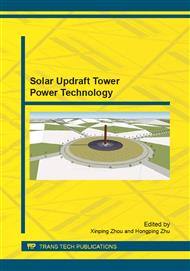p.3
p.9
p.15
p.25
p.35
p.41
p.47
p.57
Thermodynamic Behaviour of the Solar Updraft Tower: A Parametric Model for System Sizing
Abstract:
The solar updraft tower (SUT) concept is an exciting renewable technology with the potential to deliver high power output. A comprehensive SUT sizing computer model has been developed to determine power output and thus appropriate system dimensions for different ambient conditions. The efficient thermodynamic model performs steady-state macro-scale simulations incorporating radiation and natural convection heat transfer mechanisms. The solar collector is simulated as a discretised, axisymmetric, radial system composed of thermal components. A set of linear simultaneous equations describes the heat exchanged between these components and is solved by matrix inversion. The short computation time of the model makes it ideal for parametric analysis of SUT plants across a range of dimensions. The thermodynamic performance of the collector proves to be a limiting factor of system power output. Results from the model show that for given chimney dimensions, there is a maximum collector size beyond which no further useful heat is added to the air as the system has reached thermal equilibrium. Therefore the only way to increase power output further is to increase chimney height and diameter as well as extending the collector diameter.
Info:
Periodical:
Pages:
3-7
Citation:
Online since:
January 2013
Authors:
Keywords:
Price:
Сopyright:
© 2013 Trans Tech Publications Ltd. All Rights Reserved
Share:
Citation:



